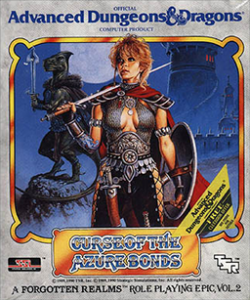CotAB: Cover Girl
One bond left. That means I’m into the endgame. There are five villains, but you defeat one in the intro chapter and one is saved for the very end, so the midgame has three. The last one I beat, the cult of Moander, was such a cakewalk that I suspect I’ve been doing the three middle sub-quests in the wrong order (if indeed there is an ordering; possibly they’re all designed to be accessible to new characters, and just became easier as my characters leveled up).
 In Moander’s pit, I teamed up with Alias, the protagonist of the novel. I honestly didn’t think she was going to show up in the game, seeing how her function in the novel is taken by the player characters, but I suppose the leaving her out would have made a lie of the box art. Taken directly from the novel, and repeated within the game as its splash screen, it shows the heroine with her 80’s hair and ridiculous peekaboo armor. That armor seems to be her chief defining visual trait: the makers of the game even went so far as to make a special combat-mode sprite for her, with a visible diamond-shaped flash of skin on the chest.
In Moander’s pit, I teamed up with Alias, the protagonist of the novel. I honestly didn’t think she was going to show up in the game, seeing how her function in the novel is taken by the player characters, but I suppose the leaving her out would have made a lie of the box art. Taken directly from the novel, and repeated within the game as its splash screen, it shows the heroine with her 80’s hair and ridiculous peekaboo armor. That armor seems to be her chief defining visual trait: the makers of the game even went so far as to make a special combat-mode sprite for her, with a visible diamond-shaped flash of skin on the chest.
The reasons behind this character design are as obvious as the target demographic it’s intended to appeal to. Selling games through sex appeal is hardly new, and hardly rare. At least the cover art here shows something that’s actually found in the game, which makes it more honest than a lot of games of the same era. But still not especially honest: anyone who bought it with the intention of ogling Alias during gameplay would probably be disappointed in her EGA representation, and also in how little time she sticks around. The idea of making good on the promises of the cover art — of making a young woman in revealing clothing into a constant feature of gameplay — really didn’t take off until Tomb Raider, which was still years away at this point.
The bait-and-switch approach is still alive and well, though, and has reached its pinnacle with Evony, the mediocre web-based kingdom-building game whose infamously irrelevant ads, showing pictures of lingerie models, have far passed the point of being distinguishable from satire. I’ve blocked Evony ads on this site, because I frankly find them embarrassing, but if there’s one good thing they’ve done, it’s exposing the sleaziness of game advertising in general through a kind of reductio ad absurdum. It’s easy to get inured to exploitative imagery, but now, when I look at Alias, I can’t help but see her as a step on the road to Evony.
 Comments(0)
Comments(0)